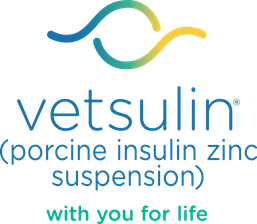

Feeding Schedule
Learn More About Dosing & Administration
Tailoring Diets for Healthy Dogs
Good glycemic control is dependent upon a controlled and consistent dietary intake. The dietary requirements of a dog with diabetes is highly variable—diet must be individually tailored for each dog.
Body Weight is a Major Factor
Obese dogs require reduced caloric intake, either through feeding a calorie-restricted diet or by feeding a reduced quantity of the normal diet. Increasing physical activity will also be beneficial in obese dogs. Conversely, underweight dogs may require calorie-rich diets such as pediatric or convalescent diets.
Consider Concurrent Diseases
It’s important to consider what other diseases and needs your patient might have. It may be that the dietary management for these associated problems is more critical than a specific ‘diabetic’ diet.
Timing of Meals
Traditionally, the dog’s daily food intake should be divided into two meals. Meals should be timed so that the absorption of glucose from the gastrointestinal tract coincides with the peak action of the administered insulin. This will minimize fluctuations in blood glucose concentrations and thus episodes of hyperglycemia and hypoglycemia.
Fiber-rich diets have been shown to slow the postprandial glucose surge in dogs, which consequently improves glycemic control.
For Once-Daily Insulin Injections:
Calculate the total daily amount of food the dog should be fed.
Give the first meal (two-thirds of the daily amount) prior to the morning Vetsulin injection. This allows the owner to confirm the dog is feeling well and eating normally before administering the insulin.
The second meal (the remainder of the daily amount) is usually given about 8-10 hours later, when the action of the crystalline portion is at its peak.
For Twice-Daily Insulin Injections:
The first meal (half of the daily amount) is given just before the morning insulin injection. This allows you to see that the dog is feeling well and eating normally before the insulin is given.
The second meal (the remainder of the daily amount) is usually given about 10–12 hours later, prior to the second insulin injection.
Help Your Practice Manage Diabetes Mellitus
View and download resources and tools that will assist your hospital, inform your team, and help with clients.

Blood Glucose Curve Generator
Create a blood glucose curve to monitor and evaluate diabetes treatments.

Client Discharge Form
Create a customized, printable form for clients about their new diagnosis.

Diabetes Resources
Access online tools and more to support staff and pet parents.
No items to show.
Learn More About Dosing & Administration
Important Safety Information:
Vetsulin® should not be used in dogs known to have a systemic allergy to pork or pork products. Vetsulin is contraindicated during periods of hypoglycemia. Keep out of reach of children. As with all insulin products, careful patient monitoring for hypoglycemia and hyperglycemia is essential to attain and maintain adequate glycemic control and prevent associated complications. Overdosage can result in profound hypoglycemia and death. The safety and effectiveness of Vetsulin in puppies, breeding, pregnant, and lactating dogs has not been evaluated. See package insert for full information regarding contraindications, warnings, and precautions.
References:
1. Martin GJ, Rand JS. Pharmacology of a 40 IU/ml porcine lente insulin preparation in diabetic cats: findings during the first week and after 5 or 9 weeks of therapy. J Feline Med Surg. 2001;3(1):23–30. 2. Vetsulin® (porcine insulin zinc suspension) [Freedom of Information Summary]. Millsboro, DE: Intervet Inc.; 2008. 3. Data on file, Merck Animal Health. 4. Graham PA, Nash AS, McKellar QA. Pharmacokinetics of porcine insulin zinc suspension in diabetic dogs. J Small Anim Pract. 1997;38(10):434–438. 5. Martin GJ, Rand JS. Pharmacokinetic and Pharmacodynamic Study of Caninsulin in Cats with Diabetes Mellitus. 2000: Internal Study Report. 6. Feldman EC, Nelson RW. Canine and Feline Endocrinology and Reproduction. 3rd ed. St. Louis, MO: Saunders; 2004:539–579. 7. Tennant B, ed. BSAVA Small Animal Formulary. 4th ed. Gloucestershire, UK: British Small Animal Veterinary Association; 2002. 8. Feldman EC, Nelson RW. Canine and Feline Endocrinology and Reproduction. 3rd ed. St. Louis, MO: Saunders; 2004:486–538. 9. Reusch C. Feline diabetes mellitus. In: Ettinger SJ, Feldman EC, eds. Textbook of Veterinary Internal Medicine. 7th ed. St. Louis, MO: Saunders; 2010:1796–1816. 10. Nelson RW. Canine diabetes mellitus. In: Ettinger SJ, Feldman EC, eds. Textbook of Veterinary Internal Medicine. 7th ed. St. Louis, MO: Saunders; 2010:1782–1796. 11. Burgaud S, Riant S, Piau N. Comparative laboratory evaluation of dose delivery using a veterinary insulin pen. In: Proceedings of the WSAVA/FECAVA/BSAVA congress; 12–15 April 2012; Birmingham, UK. Abstract 121. 12. Burgaud S, Guillot R, Harnois-Milon G. Clinical evaluation of a veterinary insulin pen in diabetic dogs. In: Proceedings of the WSAVA/ FECAVA/BSAVA congress; 12–15 April 2012; Birmingham, UK. Abstract 122. 13. Burgaud S, Guillot R, Harnois-Milon G. Clinical evaluation of a veterinary insulin pen in diabetic cats. In: Proceedings of the WSAVA/FECAVA/BSAVA congress; 12–15 April 2012; Birmingham, UK. Abstract 45. 14. Davison LJ, Walding B, Herrtage ME, Catchpole B. Anti-insulin antibodies in diabetic dogs before and after treatment with different insulin preparations. J Vet Intern Med. 2008;22:1317-1325. 15. Banfield State of Pet Health 2016 Report. p 12-13.
